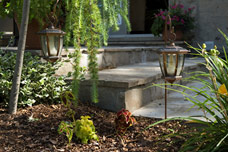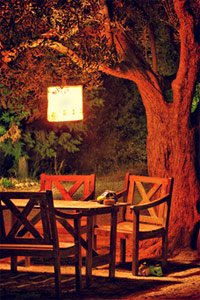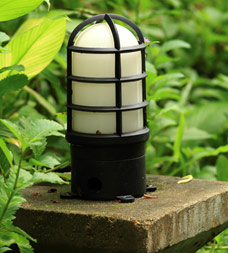Know what the consumer is responsible for; know what the lighting contractor is responsible for
Landscape Ontario, the trade organization governing more than 2,000 certified horticultural professionals across the province, benefits from keeping homeowners educated. It means the clients its members serves can better appreciate the quality of work horticultural professionals produce. Find the full text below and make sure the landscape lighting you pay for is up to snuff.
General Conditions
Utilities

Client’s Authorized Representative

Protection of Work and Property
The Contractor shall maintain adequate protection of all his work from damage and shall protect the Client’s and adjacent property from injury or loss arising from this contract.
Examination and Verification of the Drawing and Site
It shall be the Contractor’s responsibility to report to the Client any deviations between drawings, specifications and the site.
Ordinances and Regulations
All local and municipal Rules and Regulations relating to any portion of this work are hereby incorporated into and made a part of these specifications and their provisions shall be carried out by the Contractor. Anything contained in these specifications shall not be construed to conflict with any of the above mentioned regulations or requirements, and where a conflict may occur the regulations of the governing code shall be adhered to. However, when these specifications and/or drawings call for or describe materials, workmanship or construction of a better quality, higher standard or larger size, these specifications and/or drawings shall take precedence over the requirements of said Rules and Regulations.
Materials and Workmanship

Permits and Inspections
Any permit for the installation or construction of any of the work included under this contract, which is required by any of the legally constituted authorities having jurisdiction, shall be obtained and paid for by the Contractor, each at the proper time. He/she shall also arrange for and pay all costs in connection with any inspections and examinations required by these authorities. In all cases, where inspection of the lighting system work is required and/or where portions of the work are specified to be performed under the direction and/or inspection of the Client, the Contractor shall notify the Client of the time when such inspection and/or direction is required. Any necessary re-excavation or alterations to the system needed because of the failure of the Contractor to have the required inspections, shall be performed at the Contractor’s expense.
Controller Location
The Client and Contractor shall mutually agree on the location of the lighting controller.
Changes or Additional Work

Unclassified Excavation
Excavation shall be unclassified and shall include all materials encountered. All materials or matter that cannot be excavated by normal excavation means shall be brought to the attention of the Client and an adjustment in price agreed upon before excavation of these areas proceeds. When additional backfill material is needed to replace rock and/or other unsuitable materials, it shall be the Client’s responsibility and expense to supply such material. for backfill, to the Contractor, at the site locations designated by the Contractor. It shall also be the Client’s responsibility to dispose of the unsuitable materials removed from the trench that cannot be used in the backfill operations, unless the foregoing is otherwise agreed upon by the Client and the Contractor.
Insurance
The Contractor shall maintain in force Public Liability and Automobile Insurance with Bodily Injury and Property Damage for electrical work. The Contractor is responsible for insuring all personnel under Worker’s Compensation Board coverage under the appropriate electrical classification.
Guarantee
The entire lighting system shall be guaranteed to be complete as per specifications in every detail for a period of one (1) year from the date of its acceptance, and the Contractor HEREBY AGREES to repair or replace any such defects occurring within that year, free of expense to the Client. Lamps are not guaranteed unless otherwise specified.
As-Built Drawings
Upon completion of the work, (if requested beforehand) the Contractor shall prepare an as-built drawing of the system indicating:
- Junction Box Locations
- Fixture Locations
- Wire Run Locations
- Transformer Locations
- Controller Location
The as-built drawing must be proportionally and diagrammatically correct.
Installation
Excavation and Backfill
1. Trenching
Trenches for electrical conduit and wiring shall be of sufficient width to permit proper handling and installation of the pipe and fittings. Trenches containing conduit for line voltage wiring must have a minimum cover of at least 18” wherever possible and vehicle areas 24” in depth. (refer to Rule 12-012 and Table 53 of the C.E.C. Trenches containing conduit for low voltage wiring must have a minimum cover of at least 12” wherever possible. The backfill shall be thoroughly compacted up to original grade level.
2. Pulling
Where soil conditions allow the pipe depths of cover described above to be met, the electrical conduit may be directly installed without trenching by the use of a vibratory plough. In each of the above operations, the Contractor is responsible for keeping the interior of the conduit free from dirt and debris, and for restoring the site to its original condition, including responsibility for damage to existing trees, shrubs and structures, along with settlement of trenches within the warranty period.
Underground Conduit
1. PVC
All P.V.C. conduit shall be installed in accordance with Rules 12-1200 through 12-1220 inclusive of the C.E.C. All P.V.C. conduit shall be cut with a hacksaw or approved P.V.C. cutters, so as to ensure a square cut. Burrs at cut ends shall be removed prior to installation so that a smooth, unobstructed pull will be obtained. All P.V.C. conduit joints shall be solvent weld joints. Only the solvent recommended by the manufacturer shall be used. All P.V.C. pipe and fittings shall be installed as outlined and instructed by the pipe manufacturer and it shall be the Contractors responsibility to make arrangements with the pipe manufacturer for any field assistance that may be necessary. The Contractor shall assume full responsibility for the correct installation.
2. Poly Pipe
Can be used as the recommended protection for low voltage lighting wire protection.
Pull Boxes and Junction Boxes
In the event that pull boxes and/or junction boxes are used as part of the conduit system, they shall be of an approved type suitable for outdoor installation. The above mentioned boxes shall also remain accessible at all times. (Refer to Rule 12-3018 of the C.E.C.) The size of the required pull boxes shall be determined using Rule 12-3042 of the C.E.C.
Tree Wiring: Procedures
In-Ground Routing and Depth of Conduits and Wire
- Run all conduits parallel to existing main roots anywhere inside “Drip Line” of tree.
- Burial depth as per code where possible.
- Extreme caution to be taken when excavating within 1.3M of tree trunk, so as not to injure tree “buttress flair” root structure.
- All grade mounted fixtures and mounting stakes located so as to allow for normal plant growth with special attention paid to protecting roots and “buttress flair” root structure from po
Tree Work/Plant Selection
Trees to be selected for lighting installation are to be in healthy, vigorous, growing condition, free of structural deficiencies and free of disease and decay.
Location and Routing
All wire, hardware and fixtures are to be located so as to allow for “normal” plant growth twith special attention paid to:
- Do not mount hardware or fixtures and do not route wire through any “branch or trunk unions.”
- Do not encircle any branch or trunk with wire or any other hardware.
- Keep a minimum of 12” between all new and existing installations of tree hardware.
Above Grade Wire Protection
- All wire to be protected by P.V.C. conduit or water resistant flexible conduit (liquid tite) to a minimum of 8’ above grade.
- Low voltage lines carrying over 100 VA (sample) to be installed as above.
- All connections to be made in approved junction boxes.
Wire Type
- Low Voltage – 12 Gauge, 2 Wire, UV Rated Coating.
- Line Voltage – 12 Gauge, N.M.W.U. or S.J.T.W.
Wire Fastening
- All fastening hardware to be corrosion resistant or made of non-corrodible materials.
- Conduits are to be secured to tree with normal clips and hardware.
- Wire to be fastened with galvanized wire staples which have stand off nubs.
- Do not drive staples into tree past the stand-off nubs so as to squeeze wire but instead leave wire loose so as to allow for tree sway, tree growth, and wire expansion and contraction.
- Leave a 12” slack or service loop at each junction or fixture to allow for wire “play” and for servicing or relocation.
Mounting Fixtures, Junction Boxes and Ballasts
- All to be mounted with a “stand off’type galvanized lag bolt, minimum diameter 3/8”, leaving a minimum of 1” between limb and fixture.
- Pre-drill all holes for bolt installation to bolt shank diameter.
- Limbs for fixture installation to be of sufficient size (minimum 2” diameter) and strength to support fixture and hardware installation.
Tree Wiring: Maintenance
- A yearly inspection and maintenance of all tree installations is an absolute must and all customers should be made aware of this fact at the time of purchasing system.
- As determined at time of inspection such procedures as follows will be necessary from time to time:
- “Back-Off’ any screw type fastening hardware so as to accommodate tree growth.
- Cut off existing wire-mounting staples and install new staples as required to accommodate tree growth.
- Relocate or re-secure grade mounted fixtures so as to accommodate for plant (including root) growth and climatic effects.
- All electrical installations in trees should conform with the Occupational Health and Safety Act which requires a minimum clearance of 10’from any existing electrical utility or energized conductor.
- Installation personnel, when climbing over 3metres above ground level, must use climbing equipment and techniques which conform with the Occupational Health and Safety Act and which are C.S.A. approved.
- It is strongly recommended that personnel who are involved in the design and installation of tree mounted lighting systems be well versed in arboriculture as it applies to tree identification, growth habits and care.
Below Grade Wiring
All below grade wiring shall be installed in accordance with rule 12-012 and table 53 of the C.E.C.
Sleeves
Recommend use of rigid pipe similar to P.V.C. or A.B.S. When installing conduit under sidewalks, roadways, etc., it shall be installed in a sleeve at least 4” in diameter. The sleeve that is used shall be of an approved type and must be installed at the same depth as the remainder of the conduit system. Electrical Sleeves must be DEDICATED for electrical lines only. All sleeving must be sealed and clearly marked as to location for easy location.
Transformers
All transformers used in a low voltage lighting installation shall be C.S.A. approved in addition to having local Hydro approval. All transformers must be installed in accordance with Section 16 of the C.E.C. All transformers must be properly fused in accordance with Rules 16-100 through 16-106 and Rules 16-200 through 16-208 inclusive of the C.E.C. All transformers must be installed in accordance with the manufacturer’s recommendations and in such a manner as to be kept clear of debris, water, snow, etc.
Final Hook Up
All line voltage hookups must be performed by or under the direct supervision or a qualified electrician.
Materials
Fixtures
All fixtures installed in the Landscape Lighting system shall be C.S.A. approved and be suitable for outdoor installation.
Wire
All wiring used in the installation shall be C.S.A. approved. It is recommended that 12 gauge wire be used in all landscape lighting installations.
Power Supply Distribution
Protection
The Landscape Lighting system must be protected by an approved fuse or breaker in accordance with Rules 14-100 through 14-304 inclusive of the C.E.C.
Power Supply
The supply line brought to the outside wall of the building shall be designated for the sole use of the Landscape Lighting system and shall be minimum 12 gauge in size.
Maintenance
Overall Maintenance
All Landscape Lighting systems shall be maintained by the installing company for a period of one year after the date of installation. A regular maintenance check once a year is required after the first year to monitor tree growth and landscape changes and their effect on the lighting system, See Tree Maintenance Section C.4.